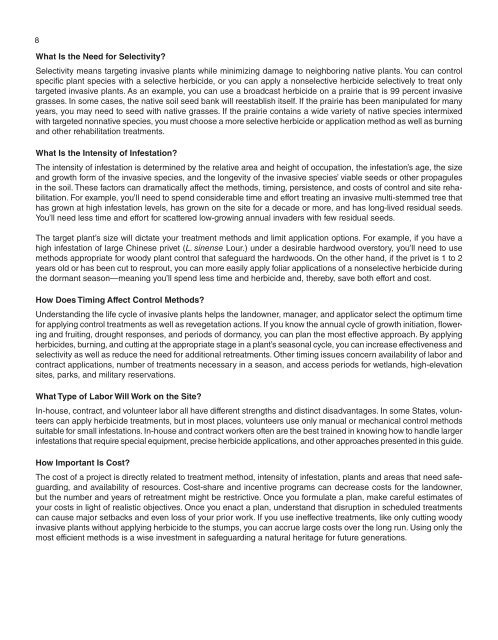A Management Guide for Invasive Plants in Southern Forests James ...
A Management Guide for Invasive Plants in Southern Forests James ...
A Management Guide for Invasive Plants in Southern Forests James ...
- No tags were found...
Create successful ePaper yourself
Turn your PDF publications into a flip-book with our unique Google optimized e-Paper software.
8What Is the Need <strong>for</strong> Selectivity?Selectivity means target<strong>in</strong>g <strong>in</strong>vasive plants while m<strong>in</strong>imiz<strong>in</strong>g damage to neighbor<strong>in</strong>g native plants. You can controlspecific plant species with a selective herbicide, or you can apply a nonselective herbicide selectively to treat onlytargeted <strong>in</strong>vasive plants. As an example, you can use a broadcast herbicide on a prairie that is 99 percent <strong>in</strong>vasivegrasses. In some cases, the native soil seed bank will reestablish itself. If the prairie has been manipulated <strong>for</strong> manyyears, you may need to seed with native grasses. If the prairie conta<strong>in</strong>s a wide variety of native species <strong>in</strong>termixedwith targeted nonnative species, you must choose a more selective herbicide or application method as well as burn<strong>in</strong>gand other rehabilitation treatments.What Is the Intensity of Infestation?The <strong>in</strong>tensity of <strong>in</strong>festation is determ<strong>in</strong>ed by the relative area and height of occupation, the <strong>in</strong>festation’s age, the sizeand growth <strong>for</strong>m of the <strong>in</strong>vasive species, and the longevity of the <strong>in</strong>vasive species’ viable seeds or other propagules<strong>in</strong> the soil. These factors can dramatically affect the methods, tim<strong>in</strong>g, persistence, and costs of control and site rehabilitation.For example, you’ll need to spend considerable time and ef<strong>for</strong>t treat<strong>in</strong>g an <strong>in</strong>vasive multi-stemmed tree thathas grown at high <strong>in</strong>festation levels, has grown on the site <strong>for</strong> a decade or more, and has long-lived residual seeds.You’ll need less time and ef<strong>for</strong>t <strong>for</strong> scattered low-grow<strong>in</strong>g annual <strong>in</strong>vaders with few residual seeds.The target plant’s size will dictate your treatment methods and limit application options. For example, if you have ahigh <strong>in</strong>festation of large Ch<strong>in</strong>ese privet (L. s<strong>in</strong>ense Lour.) under a desirable hardwood overstory, you’ll need to usemethods appropriate <strong>for</strong> woody plant control that safeguard the hardwoods. On the other hand, if the privet is 1 to 2years old or has been cut to resprout, you can more easily apply foliar applications of a nonselective herbicide dur<strong>in</strong>gthe dormant season—mean<strong>in</strong>g you’ll spend less time and herbicide and, thereby, save both ef<strong>for</strong>t and cost.How Does Tim<strong>in</strong>g Affect Control Methods?Understand<strong>in</strong>g the life cycle of <strong>in</strong>vasive plants helps the landowner, manager, and applicator select the optimum time<strong>for</strong> apply<strong>in</strong>g control treatments as well as revegetation actions. If you know the annual cycle of growth <strong>in</strong>itiation, flower<strong>in</strong>gand fruit<strong>in</strong>g, drought responses, and periods of dormancy, you can plan the most effective approach. By apply<strong>in</strong>gherbicides, burn<strong>in</strong>g, and cutt<strong>in</strong>g at the appropriate stage <strong>in</strong> a plant’s seasonal cycle, you can <strong>in</strong>crease effectiveness andselectivity as well as reduce the need <strong>for</strong> additional retreatments. Other tim<strong>in</strong>g issues concern availability of labor andcontract applications, number of treatments necessary <strong>in</strong> a season, and access periods <strong>for</strong> wetlands, high-elevationsites, parks, and military reservations.What Type of Labor Will Work on the Site?In-house, contract, and volunteer labor all have different strengths and dist<strong>in</strong>ct disadvantages. In some States, volunteerscan apply herbicide treatments, but <strong>in</strong> most places, volunteers use only manual or mechanical control methodssuitable <strong>for</strong> small <strong>in</strong>festations. In-house and contract workers often are the best tra<strong>in</strong>ed <strong>in</strong> know<strong>in</strong>g how to handle larger<strong>in</strong>festations that require special equipment, precise herbicide applications, and other approaches presented <strong>in</strong> this guide.How Important Is Cost?The cost of a project is directly related to treatment method, <strong>in</strong>tensity of <strong>in</strong>festation, plants and areas that need safeguard<strong>in</strong>g,and availability of resources. Cost-share and <strong>in</strong>centive programs can decrease costs <strong>for</strong> the landowner,but the number and years of retreatment might be restrictive. Once you <strong>for</strong>mulate a plan, make careful estimates ofyour costs <strong>in</strong> light of realistic objectives. Once you enact a plan, understand that disruption <strong>in</strong> scheduled treatmentscan cause major setbacks and even loss of your prior work. If you use <strong>in</strong>effective treatments, like only cutt<strong>in</strong>g woody<strong>in</strong>vasive plants without apply<strong>in</strong>g herbicide to the stumps, you can accrue large costs over the long run. Us<strong>in</strong>g only themost efficient methods is a wise <strong>in</strong>vestment <strong>in</strong> safeguard<strong>in</strong>g a natural heritage <strong>for</strong> future generations.
















